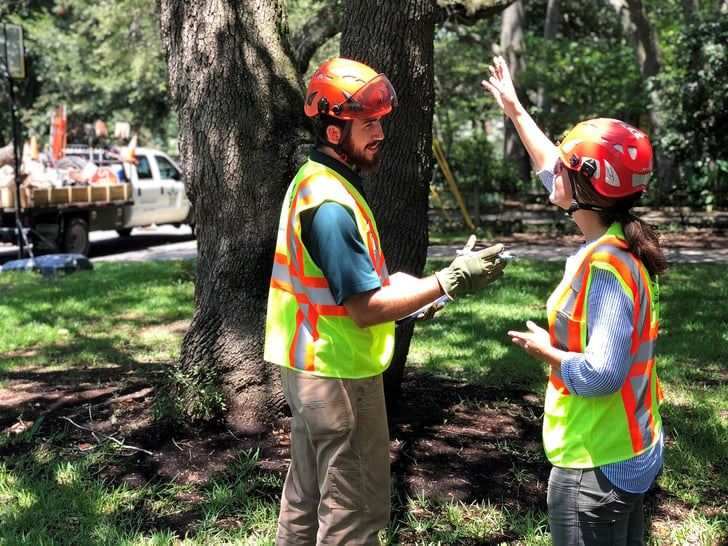Almost every client we talk to realizes that proper pruning is one of the most vital parts of commercial tree care. This is likely due to the obvious property damage and utility outages caused by limbs breaking when not trimmed beforehand.
However, there are many other important aspects of tree care. All of which play a crucial role in keeping the valuable trees on your property looking their best while staying healthy and strong.
No property owner wants to deal with damage from falling trees or limbs. And you obviously want your trees to live as long as possible, to maximize their value and extend the numerous benefits for your residents, staff, and guests.
That’s why we’re spending some time in this article to give you a deep-dive on tree planting, proper maintenance, and even some specialty services you may not be familiar with yet. At the end of the post, we put together a list of fast-growing trees (region by region) in case you’re considering adding more trees to your property soon.
Countless Benefits of Trees
If there’s a downside to planting more trees, we have yet to figure out what it is. The benefits go on and on, with new research popping up all the time on additional benefits of trees that even we hadn’t previously considered.
In this blog, we often discuss the importance of adding shade to commercial properties to help people combat the dangers of heat stress. And while stylish shade structures like wind sails, pergolas, and patio covers are wonderful options, it’s hard to argue against planting a handsome live oak or maple tree whenever possible.
After all, trees not only add healthy shade but also improve air quality while absorbing pollutants like ammonia and sulfur dioxide. They benefit the environment as much as they do humans by removing harmful carbon from the atmosphere.
Further Tree Benefits Include:
- Lowers utility costs through strategic building shading
- Helps prevents erosion
- Reduces noise and provides windbreaks
- Promotes and enables biodiversity
- Proven to ease anxiety
- Earn carbon credits for planting trees (certain regions)
- Visual interest through natural wonder and longevity (examples ahead)
What’s the starting point if you want in on some of these benefits above?
.jpg?width=728&height=485&name=DSC00899%20(1).jpg)
Proper Tree Planting Commercial Tree Care
One key advantage Yellowstone Landscape customers enjoy is our certified tree experts working in tandem with experienced landscape designers. Any professional tree service can trim limbs and remove diseased trees. But top-notch arborists with broad landscaping knowledge and training provide comprehensive tree care.
Many future tree maintenance costs can be dramatically reduced through expert planting strategies. For example, species selection is critical. Some trees thrive when planted in groups while others do best planted alone (and some work well in either situation).
It’s also important to know where trees were initially grown since this impacts how they adapt to your property’s environment. How trees are grown in the nursery can affect their long-term health too. Bare root, balled and burlapped, container-grown, and spade-dug trees all have installation nuances that matter.
Other tree planting considerations include proper watering techniques for the first two years, soil amendments, and tree staking—more details on these are below.

Tree Guying and Staking
Giving newly planted trees extra support through staking or tree guying means the plant has the best chance for longevity and growing into the ideal shape. What’s the main difference between guying and staking? It’s the placement of the support attachments and the type of tree being supported.
Staking is typically best for smaller or containerized species. The stakes are installed in the ground parallel to the trunk. The support straps or ropes run parallel to the ground.
Tree guying works great for larger transplanted trees. Stakes are placed further from the trunk than with staking, and support straps run at a downward angle from the tree to the ground.
Guying is suggested for windy conditions but will likely need more adjustments than staking over time.
These two tree maintenance techniques are vital in hurricane-prone areas, and they also:
- Strengthen the root system
- Correct leaning
- Encourage vertical growth
- Are ideal for fast-growing tree species
Advantages of Fast-Growing Trees
If your property goals involve planting trees, you can achieve those goals quicker with certain species. How quick? One example is the Empress Tree, with a blazing growth rate of up to 15 feet per year!
While few trees match that speed, the eleven we list for you at the end of this article are still impressive. These fast growers can quickly add shade to your parking lot and shield your AC units from the sun in no time. They also give you nearly immediate aesthetic enhancement.
The best part is you don’t have to wait long for the property value increase that comes with tree installation or the improved shopper appeal trees have at retail locations.
Commercial Tree Care
Once new trees are installed, they’re on their way to becoming the reverential giants that all living beings can enjoy. Ongoing tree care helps ensure that’s possible by keeping them alive and well.
Simple things like proper mulch levels (about three inches deep) and protecting tree trunks from wildlife and lawn care equipment make positive impacts. Too much mulch can lead to disease, while too little allows valuable moisture to evaporate. Young tree trunks are delicate, so a weed trimmer can cause serious damage.
Then there are detailed aspects of tree care programs like Yellowstone Landscape’s arborists perform, such as:
- Soil analysis
- Deep root feeding
- Nutrient adjustments
- Treating fungal diseases
- Biological disease control
- Integrated pest management
- Consultations before new construction (avoids root damage)
What about trees that are irreplaceable?
Lightning Protection for Trees
Recent headlines highlight the importance of historically valuable trees, with a California colony of Jurupa Oaks believed to be around 13,000 years old. And a Veteran’s monument in Pennsylvania is receiving a sapling propagated from a 400-year-old tulip poplar—the last known surviving “Liberty Tree.”
An often overlooked threat to priceless trees is lightning strikes. Even when this danger isn’t overlooked, property owners may be unaware protection exists.
A lightning protection system provides a low-resistance path for lightning to follow into the ground, instead of destroying the tree. Air terminals are installed high in the tree while copper lines trace the trunk downward, heading outwardly to a grounding rod. Certified arborists are a must with specialty services like this that require intricate, careful work at dangerous heights.
Protecting your property’s trees from lightning does more than protect the plant structure and health. You’re also reducing the risk of property damage and harm to people.
Arborists, The Ultimate in Tree Care
From saplings to skyscraping mature trees, your best option for maintaining their health is a certified arborist. These professionals go through rigorous and continuously updated training to ensure young saplings get properly rooted and rustle near the clouds one day.
Yellowstone arborists handle all the common maintenance tasks we noted above and use advanced staking and guying techniques based on decades of experience. Our teams install lightning protection systems, too, with the added advantage of an integrated landscaping experience.
This means your most valuable trees get protection, and the surrounding landscape elements are part of the protection plan.
Many people think only of chainsaws and climbing gear when it comes to arborists. Yet, that’s just the tip of the iceberg in this valuable craft. Arborists provide so much more, including:
- Tree risk assessments
- Pruning to maximize sunlight allowance
- Guidances on local tree regulations
- Offering alternatives to tree removal

Conclusion
It’s clear that tree care goes well beyond trimming and pruning. Those services are vital to tree health, but a quality program begins even before a shovel touches the dirt for planting.
With a comprehensive tree maintenance strategy, your residents, guests, and workforce receive many more years of each tree’s benefits (stress reduction, less air pollution, cooler green spaces, etc.). We discussed the nuances of species selection, nursery growth categories, and grouping best practices. And with details for proper staking, tree guying, and vital maintenance steps, you can give your plants the best chance at ideal growth and longevity.
If this was the first time you’ve read about lightning strike solutions for trees, we’re glad to shed light on that topic. As more people discover this solution is available, many more irreplaceable trees will live on.
Having the chance to protect natural wonders and brighten up green spaces keeps us excited to work in this industry. We’re always ready to talk with you about achieving that for your property. So contact Yellowstone Landscape today.
*Just enter your email address to grab the List of Fast-Growing Trees Region By Region.
*Graphic with same info.


